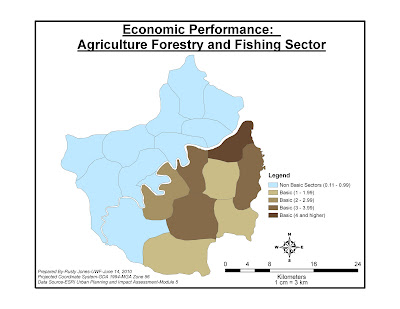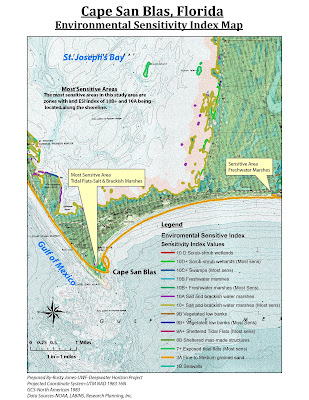Location Decisions for Couple Relocating to Gainesville, FL Area
I found this exercise to be very educational in seeing the steps necessary to produce this analysis. The instructions were very clear and I had no difficulties in doing the tasks. The most challenging parts were putting the multiple data frames together for the maps, trying to develop meaningful legends (hard) and understanding the transition from classification to a value based system.
Comments on the Weighted Overlays:
The two weighted overlays show that there could be many factors that influence the outcome of a situation. In this particular example the couple has chosen to use 4 parameters for the analysis. The parameters being: proximity to the University and hospitals, demographics of the age of the population (showing the area with the most 40-49 year olds) and the median home values in the area. Two different outcomes were weighted for the analysis. Analysis 1 shows equal weighting, or 25% for each parameter. Analysis 2 shows the proximity to the University and hospitals comprising 80% of the analysis. Based on the analyses both show the same tracts as being the best place to live. These tracts are on the west side of the city. I believe that by having a thorough interview with the couple would help with the weighting. This would most likely skew the results. Other factors that may play into the analyses are travel times to the University and hospitals and the schedules that the couple may need to adhere to. So it could be that the Dr. may have higher priorites to be in proximity to a hospital than than the professor travelling to the University. The results may also change if the the couple has a lower budget for housing and would choose to obtain a property below the highest median value of the area.
Wednesday, June 23, 2010
Wednesday, June 16, 2010
Week 5-Urban Planning and Impact Assessment
ESRI-Urban Planning and Impact Assessment-Module 5 Exercises
This maps shows the occupancy percentage of University Students for Pewter City. Pewter City is a fictitious city developed by the Australia's Queensland State Government, Department of Natural Resources. 

This map shows the Location Quotient (LQ) for the Peltrum Region (fictitious). This in order to understand what industries are driving the economy of a region. This maps shows the LQ for the Agriculture and Fishing Sectors within the Peltrum region and the basic and non-basic sectors.
These exercises where valuable for me in learning about creating queries, template and legend layouts, joins and spatial selections.
Sunday, June 13, 2010
Oil Animation Exercise
Deepwater Horizon Oil Spill Animation Sequence
Link below:
http://students.uwf.edu/rgj1/Oil%20Animation/RGJ-OilAnimation061310.avi
GIS Disaster Response in the Deepwater Horizon Oil Spill
The role of GIS in the Deepwater Horizon Oil Spill has played a crucial role. When a disaster such as this has occurred, time and information is urgently needed. Time is something that can't be changed but information can. This is where GIS has been a tremendous help. In the initial stages after the disaster occurred, the need for organization was great. Thad Allen of the U.S. Coast Guard was named as Incident Commander to develop this organization. It is assumed by this observer that the Incident Commander developed teams to respond to the disaster. One of teams of first responders is undoubtedly the GIS team. With maps being a universal way of communicating, the GIS team was tasked with creating maps portraying the size and projected movement of the oil spill. This type of information is critical to prepare for the disaster. Remote Sensing is a valuable tool that was used in conjunction with on the water teams to help give some scope to the size of the spill and growth. This information has been supplied to the appropriate agencies to develop a projected landfall track of the spill. This is necessary to the Incident Command and other government officials to make judgments on where to concentrate available resources.
GIS products have not been limited to maps, but graphs, tables and other written materials too. This information has allowed placement of booms and construction of barriers in efforts to prevent damage to the sensitive shoreline. In addition, this information has been a tool in planning with the mobilization of people and boats for skimming and beach clean-up operations.
In places where the damage has already occurred, the GIS team has played a key role by measuring the extent of the damage. This has helped land managers, property owners and government officials in dispatching available resources to try and mitigate further damage to beaches, wetlands, wildlife, fish and residents of the Gulf coast. This information is also vital in determining an actual cost of this disaster. This cost is rising until the time the oil well is capped and final damage assessments are determined.
As this brief narrative states GIS is a vital element in this oil spill disaster response. GIS will continue to be an important factor in monitoring the movement of the spill, damage assessment and also in the recovery process for years (unfortunately) to come.
Link below:
http://students.uwf.edu/rgj1/Oil%20Animation/RGJ-OilAnimation061310.avi
GIS Disaster Response in the Deepwater Horizon Oil Spill
The role of GIS in the Deepwater Horizon Oil Spill has played a crucial role. When a disaster such as this has occurred, time and information is urgently needed. Time is something that can't be changed but information can. This is where GIS has been a tremendous help. In the initial stages after the disaster occurred, the need for organization was great. Thad Allen of the U.S. Coast Guard was named as Incident Commander to develop this organization. It is assumed by this observer that the Incident Commander developed teams to respond to the disaster. One of teams of first responders is undoubtedly the GIS team. With maps being a universal way of communicating, the GIS team was tasked with creating maps portraying the size and projected movement of the oil spill. This type of information is critical to prepare for the disaster. Remote Sensing is a valuable tool that was used in conjunction with on the water teams to help give some scope to the size of the spill and growth. This information has been supplied to the appropriate agencies to develop a projected landfall track of the spill. This is necessary to the Incident Command and other government officials to make judgments on where to concentrate available resources.
GIS products have not been limited to maps, but graphs, tables and other written materials too. This information has allowed placement of booms and construction of barriers in efforts to prevent damage to the sensitive shoreline. In addition, this information has been a tool in planning with the mobilization of people and boats for skimming and beach clean-up operations.
In places where the damage has already occurred, the GIS team has played a key role by measuring the extent of the damage. This has helped land managers, property owners and government officials in dispatching available resources to try and mitigate further damage to beaches, wetlands, wildlife, fish and residents of the Gulf coast. This information is also vital in determining an actual cost of this disaster. This cost is rising until the time the oil well is capped and final damage assessments are determined.
As this brief narrative states GIS is a vital element in this oil spill disaster response. GIS will continue to be an important factor in monitoring the movement of the spill, damage assessment and also in the recovery process for years (unfortunately) to come.
Wednesday, June 9, 2010
Week 4-Deepwater Horizon Oil Spill
Fishing Closure-Environmental Sensitive Index Mapping
Cape San Blas, Florida--Map No. 41
Part 1
Google Earth-Fishing Closure May 25, 2010
I orginally had some issues with the projection and tracing operations in developing this map, but in the end I believe it all came together. I learned a lot on checking my data.

Cape San Blas, Florida--Map No. 41
Part 1
Google Earth-Fishing Closure May 25, 2010
I orginally had some issues with the projection and tracing operations in developing this map, but in the end I believe it all came together. I learned a lot on checking my data.
Environmental Sensitive Mapping-ESI Index Mapping

This weeks submittal had a number of challenges and opportunities for learning. The first challenge was getting the DRG Quad map file to project correctly. It took quite some time and eventually, I went back and changed the projection for the whole project to NAD 83-UTM-16N. After the change, the quad file came into the project correctly but the graphic display was really terrible and very grainy. After seeing this I went back to LABINS and downloaded the DOQQ files for the study area. The files downloaded and projected seemlessly. When I was nearly completed with the project, I tested an export of the DRG file and found that it exported fine. I'm not sure why it looks terrible in the drawing but fine in a jpeg export. After seeing this I went back and reworked all of my maps to display the DRG, as the project requirements requested. I did include one of the DOQQ files for reference. One thing that I noticed was the beach at Cape San Blas has eroded since the DRG-Quad was mapped. Interesting! If I had the project to do over again, I would perhaps pick an area that had a larger population area. I was a bit surprised that there wasn't more booming planned for the area, but perhaps there are higher priority areas? I also would have liked to add more graphs and tables, but ran out of time with nearly 50+ hours into the whole project.
Wednesday, June 2, 2010
Week 3-Hurricanes
Hurricane Katrina-Analysis of Flooding in Hancock, Harrison & Jackson Counties, Mississsippi
I thought this project was straight forward as the instructions were excellent. Although I did have a few stumples with the labels and getting my symbology where I wanted it. If there was more time I would have liked to place some labels on the places, but thought the overall exercise was to show the extent of the flooding. I also was unclear why we put the churches layer into the drawing, unless it was to show potential shelters. I believe a more pertinent statistic would have been to show the population center within the county as this would have shown the officials where damage, help and rebuilding would most likely be needed.
I thought this project was straight forward as the instructions were excellent. Although I did have a few stumples with the labels and getting my symbology where I wanted it. If there was more time I would have liked to place some labels on the places, but thought the overall exercise was to show the extent of the flooding. I also was unclear why we put the churches layer into the drawing, unless it was to show potential shelters. I believe a more pertinent statistic would have been to show the population center within the county as this would have shown the officials where damage, help and rebuilding would most likely be needed.
Subscribe to:
Comments (Atom)











